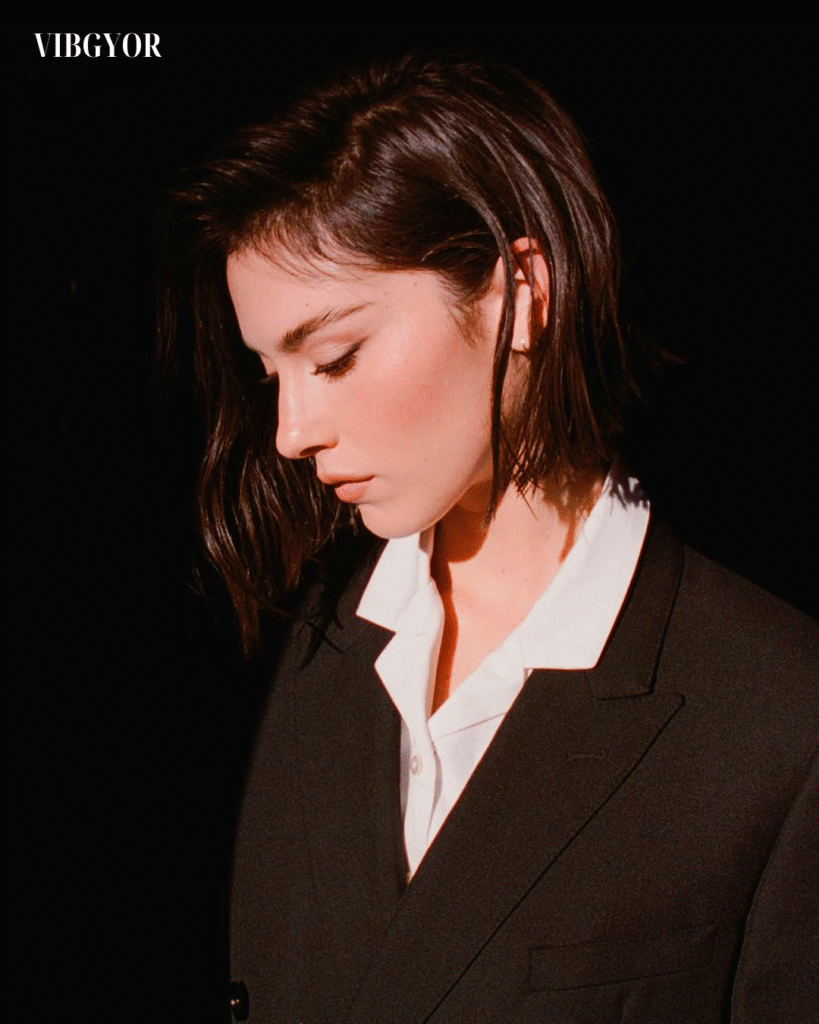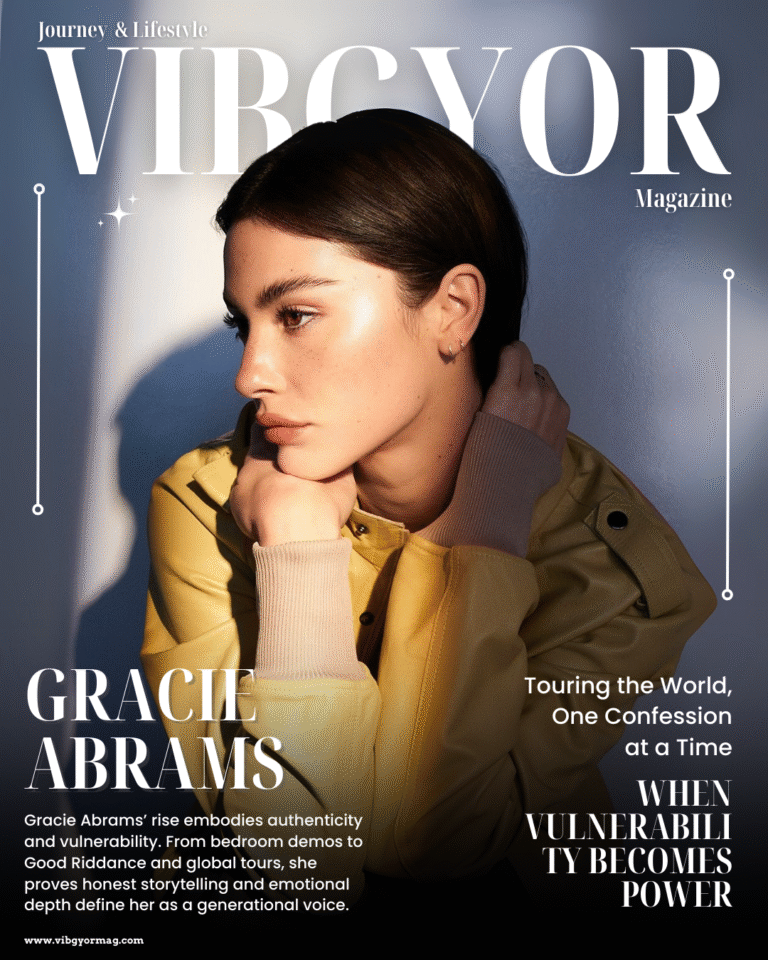In a music industry often dominated by loud, flashy productions and larger-than-life personalities, Gracie Abrams has carved out a unique lane with her quiet vulnerability and raw honesty. Known for her confessional songwriting and delicate vocal delivery, Abrams has become one of the defining singer-songwriters of her generation. With a sound often described as “bedroom pop” infused with indie-folk sensibilities, she has captured the emotions of a young audience navigating love, heartbreak, and self-discovery.
Early Life and Family Background
Gracie Madigan Abrams was born on September 7, 1999, in Los Angeles, California. She is the daughter of filmmaker J.J. Abrams and producer Katie McGrath. Growing up in a creative household, Gracie was surrounded by storytelling from an early age. However, rather than film, she gravitated toward music as her chosen form of expression.
She began writing songs as a teenager, often using her bedroom as both a studio and a sanctuary. Her early songwriting was deeply personal, reflecting her inner world and struggles with identity, relationships, and vulnerability.
Discovering Her Voice

Unlike many children of Hollywood families, Gracie avoided the spotlight for much of her youth. Instead, she cultivated her craft quietly, sharing snippets of songs on social media platforms like Instagram and SoundCloud. Her delicate voice, paired with emotionally charged lyrics, quickly resonated with listeners.
Her influences ranged from Joni Mitchell and Bob Dylan to contemporary artists like Phoebe Bridgers and Lorde. This blend of classic and modern inspirations gave her music a timeless yet relatable quality.
Breakthrough with Minor (2020)
Gracie Abrams’ official debut came in 2020 with her EP Minor. The project introduced her to a wider audience, offering songs filled with introspective storytelling and minimalist production. Tracks like I miss you, I’m sorry and 21 became fan favorites, highlighting her ability to turn heartbreak and longing into universal anthems.
The EP established Abrams as an artist unafraid of emotional transparency. She didn’t shy away from sadness, instead embracing it as a cornerstone of her artistry. Critics praised Minor for its lyrical depth and authenticity, placing her among the rising stars of the indie-pop scene.
Building Momentum: Singles and Collaborations

After the success of Minor, Abrams continued to release singles that further showcased her songwriting prowess. Songs like Brush Fire and Unlearn (a collaboration with producer Benny Blanco) demonstrated her willingness to experiment with new sounds while staying true to her intimate lyrical style.
She also began connecting more directly with her audience through live-stream performances during the COVID-19 pandemic. These stripped-down sessions, often filmed from her bedroom, emphasized the authenticity of her music and strengthened her bond with fans.
Touring and Growing Recognition
As live music returned, Gracie embarked on her first tours, performing both as a headliner and as an opener for major artists. Her ability to translate the intimacy of her recordings into a live setting won her critical acclaim. Fans described her concerts as almost therapeutic experiences—safe spaces where vulnerability and emotion were celebrated rather than hidden.
Her growing reputation also led to collaborations with other notable artists and songwriters. Industry insiders began to recognize her as one of the leading voices of the “sad girl” movement in music, alongside contemporaries like Clairo and Olivia Rodrigo.
This Is What It Feels Like (2021)
In late 2021, Abrams released her second project, This Is What It Feels Like. The collection built on her debut, offering a more refined yet still emotionally raw sound. Standout tracks like Feels Like and Rockland revealed both growth and continuity—she was evolving as an artist without losing the intimacy that defined her earlier work.
Critics noted that the project felt more confident, as though Abrams had fully embraced her role as a storyteller of emotional nuance. Fans connected deeply with the themes of longing, uncertainty, and growing up.
Debut Album Good Riddance (2023)
In February 2023, Gracie Abrams released her highly anticipated debut studio album Good Riddance, produced by Aaron Dessner of The National. The collaboration marked a new chapter in her artistry, adding rich instrumentation and layered production to her trademark confessional style.
Songs like Where do we go now? and I know it won’t work captured the complexities of endings—whether relationships, friendships, or phases of life. The album received widespread critical praise, with reviewers highlighting its cohesiveness and emotional resonance.
Good Riddance solidified Abrams as more than a promising newcomer—she was now an established artist with a clear voice in contemporary music.
Touring with Taylor Swift
One of the defining moments of Abrams’ career came in 2023 when she joined Taylor Swift as an opening act on the Eras Tour. Performing in massive stadiums introduced her to millions of new listeners and gave her the opportunity to share the stage with one of her biggest inspirations.
The experience not only expanded her fan base but also validated her status as one of the most important rising voices in pop music. Swift herself praised Abrams’ songwriting, further elevating her profile.
Artistic Identity and Influence

Gracie Abrams’ music stands out for its vulnerability. She writes about heartbreak, insecurity, and longing with a disarming honesty that resonates deeply with listeners. Unlike many pop stars who rely on spectacle, Abrams builds her artistry on intimacy and emotional connection.
Her gentle vocals and minimalist soundscapes create a sense of closeness, as if each song is a personal conversation. This authenticity has made her a voice of comfort for Gen Z audiences navigating emotional complexity in an often chaotic world.
Challenges and Criticism
Despite her success, Abrams has faced criticism, often tied to her family background. Some argue that her path to fame was eased by her father’s Hollywood status. However, fans and critics alike counter that her talent, authenticity, and hard work are the real reasons behind her rise.
She has also been candid about mental health struggles, openly discussing anxiety and self-doubt. By sharing these challenges, Abrams has strengthened her bond with fans who see her not just as an artist, but as someone who understands their struggles.
The Future of Gracie Abrams
At just 25, Gracie Abrams has already accomplished more than many artists achieve in a lifetime. With a debut album, high-profile tours, and a growing global fan base, her future looks bright.
Industry experts expect her to continue collaborating with top producers and exploring new sounds, possibly blending her indie-folk roots with more experimental pop elements. Her ability to balance vulnerability with growth suggests a long, sustainable career.
Conclusion
Gracie Abrams is more than just a rising star—she is a storyteller for a generation. Through her soft vocals and raw honesty, she has created a musical space where sadness, uncertainty, and reflection are not only accepted but celebrated.
From her early songs shared online to performing on one of the biggest tours in history, Abrams has shown that authenticity can be just as powerful as spectacle. As she continues to evolve, she represents the enduring power of music that speaks directly to the human heart.

